Abstract
Students often have difficulty understanding abstract concepts in chemistry and a low spatial ability, especially in visualizing intermolecular interactions at the submicroscopic level. Therefore, this study aims to analyze the spatial ability of students by using a 3D virtual representation as they study the curriculum topic of molecular geometry. The research was conducted with 13 male and 23 female year 10 secondary students in Jakarta, Indonesia. A qualitative methodology was employed to analyze students’ spatial abilities while they undertook learning activities using 3D virtual representation. Data collection included a spatial assessment, a quiz about prior knowledge, student worksheets, interviews, observation sheets, reflective journals, and a molecular geometry test. Learning was carried out in three stages; engage, explore, and explain. The results of the research show that students’ ability in spatial orientation is low whereas their ability in spatial relationships that involve using mental manipulation and rotation of 2D or 3D objects is more developed. Students employ this approach to develop their understanding of molecular geometry.
1. Introduction
Atoms and molecules are basic entities that must be understood by chemistry students. In addition, the characteristic of chemistry learning is meaningful if it is associated with understanding at the macroscopic, microscopic, and symbolic levels [1,2,3]. However, research shows that many, students experience difficulties with chemistry because they are unable to visualize the structure and process at the submicroscopic level and connect it with the other levels of chemical representation [4]. Basic entities cannot be sensed so spatial visualization is necessary [5]. Spatial ability is required to produce, maintain, and properly manipulate abstract visual images [6]. The National Research Council stated that spatial ability plays an important role in problem-solving and reasoning in science [7]. Margulieux also expressed a similar view that spatial abilities need to be mastered to ensure success in the STEM fields, especially in chemistry [8]. Students must be able to understand, interpret, and translate submicroscopic representations at the level of particles such as atoms and molecules. However, visualization of microstructures is difficult for learners, especially those without sufficient knowledge of chemical content and/or who lack spatial skills [6]. Al-Balushi et al., revealed that low spatial abilities hinder a student’s ability to visualize phenomena at the molecular level [5].
Students may also have difficulty linking observable phenomena with molecular interactions [9]. According to [10], studies in organic chemistry show skills in spatial abilities are (1) visualization, (2) sketching/representation, and (3) translation between 2D sketches and 3D models of molecules and their interactions. Students who have high spatial abilities can rotate and interpret molecular representations in 2D and 3D forms [11]. Spatial transformations such as these are believed to improve students’ skills in solving problems [12]. In other words, spatial abilities play an important role for students studying chemistry [6,13]. However, teachers often do not teach spatial abilities explicitly, which can lead to misconceptions or incomplete understanding of chemistry concepts [12]. Teachers often simplify spatial information contained in abstract and complex material because of limited instruction time [14].
Furthermore, debate about the improvement of spatial ability has become an issue, which is related to innate ability and trainable skills. Spatial ability can be developed over a person’s lifetime and with interventions through training [6,15,16]. Both quantitative and qualitative studies explore different perspectives of spatial abilities in relation to strategies and training. Kyllonen, Lohman, and Snow revealed that high spatial ability subjects benefited from practicing and receiving feedback; meanwhile low spatial ability persons benefited from training with visualization strategies. Therefore, this study focused on training with 3D virtual representation [17].
A variation of 3D virtual representations uses augmented reality technology [18] to virtually represent the 3D objects, allowing users to interact directly with virtual objects in real environments [19]. This method does not require students to translate 2D objects into 3D models [20]. However, much technical preparation is required for students to be able to practice spatial skills using augmented reality. Diaz, Hincapié, and Moreno suggested several toolkits that can be used to fast-track capability, including Vuforia, Unity 3D, and Blender [21]. Vuforia is a framework that provides functionality for developing augmented reality applications on mobile phones using targets or patterns, images, or objects. Vuforia tracks the image that will be used as a marker. It aims to make nodes in the image so that 3D objects can appear after being detected by a scanner, such as through a camera device, by recognizing the position and orientation of the marker [22]. Unity 3D is a set of tools that can be used to create games or mobile applications with various technologies including graphics, audio, physics, and networking technologies. Unity 3D can be used to create animation controllers on 3D model objects that have been made or markers that have been tracked using Vuforia imported to Unity 3D to position the animation to be displayed [23]. Blender is free, open-source software that is used to create multimedia content, especially 3D objects [24]. Users design the visualization of molecular shapes that will be used in training spatial abilities so that teachers can make planned instructions.
Several previous studies reported that augmented reality as a learning medium in chemistry has already been developed and implemented [25,26]. Areas of implementation include hybridizations [26], molecular geometry [27], chemical bonds [28], redox and electrochemistry [29], introductions of chemical laboratory equipment [30], and elemental chemistry [31]. These applications demonstrate that the development of virtual representation in 3D using augmented reality technology and its implications for chemistry learning is growing rapidly in Indonesia. However, studies on students’ ability to translate and analyze 2D and 3D representations of molecular shapes are limited.
This research was conducted with 36 students from one high school class in Jakarta, Indonesia, where the molecular geometry topic is studied at a year 10 level. The topic is challenging for students and teachers because chemistry is not introduced as a subject until year 10. Interviews conducted with chemistry teachers in the participating school revealed that only 50% of students achieve the required standard, which indicates that existing teaching approaches result in a poor understanding of molecular geometry. Strategies used in chemistry classrooms tend to be oriented towards mastering theory and memorization, which limits the development of student efficacy in their learning. Molecular geometry addresses abstract materials in chemistry [32] and requires students to visualize a molecular shape. 3D molecular shape modeling that is presented virtually, through a display, can be an effective alternative for teachers to develop students’ spatial abilities [33,34]. Students learn to predict and describe molecular shapes with different thought patterns from one student to another; spatial ability is the key to understanding those shapes [35]. Therefore, this study focused on the molecular geometry topic in the chemistry curriculum.
Augmented reality as a learning medium in chemistry has already been used in Indonesia, including in hybridization [26], molecular geometry [27], chemical bonding [28], redox and electrochemistry [29], introduction to chemistry laboratory equipment [30], and chemical elements [31]. At the tertiary level, there have been many studies on spatial abilities in the field of chemistry [36,37]. However, the impact on the spatial abilities and processes of high school students solving chemical problems using their spatial skills has not been carried out in previous studies [38]. Studies about spatial ability and understanding chemistry prior to the college level have been conducted [39,40,41] that show that computerized molecular modeling in learning can improve spatial abilities so that students achieve better learning outcomes in tests about structures and bonds. Students also gain a better insight into the concept of models and can explain more phenomena with the help of various models. In addition to the impact on students’ spatial abilities, the process of solving chemical problems using spatial planning has not been addressed in previous studies. Therefore, the research question of this study is, what aspects of spatial abilities do students have in learning chemistry using 3D virtual representation?
2. Literature Review
2.1. Spatial Ability
Spatial ability is defined as the ability to produce, maintain, and properly manipulate abstract visual images [6]. Spatial ability is related to an individual’s ability to search for visual fields, understand the shape and position of objects visually, and mentally manipulate representations [14]. According to Lohman, spatial abilities are divided into spatial visualization, spatial orientation, and spatial relation [42]. The aspects of these spatial abilities help to understand molecular geometry in chemistry learning. In addition, [7] stated that spatial abilities play an important role in problem-solving and reasoning in science. Aligned with that view, [8] considered that spatial skills need to be mastered for success in STEM fields. For example, chemistry students must learn about the three-dimensional structure of molecules, and students who study geology must understand the underlying structures of geomorphologic features of the earth, visualize the internal structures of the Earth, understand the chemical composition of rocks and minerals, interpret the spatial arrangement of topical features, and understand the geometries of buried tectonic plates and faults.
Spatial skills in science refer to imaginative reasoning that includes spatial orientation and spatial visualization. Spatial ability is also closely related to academic achievement, especially in chemistry [11,37,43]. Students with high spatial abilities successfully visualize organic molecules in a 3D mental form and estimate bond angles [11]. Spatial abilities play an important role in learning chemistry because students are required to visualize microstructures such as atoms and molecules. However, the visualization of microstructures is a difficult task for learners. Even at the university level, many students have difficulty with spatial thinking [44]. This difficulty is caused by low spatial abilities (most students need training to acquire these skills) and misconceptions that are held by students. In practice, students should be able to imagine how a structure would appear from different perspectives, mentally manipulate objects, and visualize the effects of operations such as rotation and reflection. This is greatly influenced by the students’ own cognitive ability. Students who are considered to have low spatial skills can be disadvantaged and have the potential to lose motivation to study atomic structures. Therefore, teachers need to design the best way to support students’ use of various modalities and related reasoning strategies in chemistry classrooms [45].
According to [6], the debate over spatial ability improvement originated from the quantitative methodologies researchers historically used. Researchers assumed and measured that participants used the same strategies to solve spatial ability tasks. Then qualitative researchers began to explore strategies and their effects on spatial ability, with participants using different strategies on a specific test item [6]. Several researchers employed an information-processing perspective to understand the development and use of spatial cognition [46]. In addition, [15] portrayed the improvement of spatial abilities through training with persistent rotation tasks. Therefore, the study analyzed spatial abilities by exploring students’ strategies to solve tasks related to spatial abilities.
Work on spatial ability test has been developed since 1930, and this study employed the Purdue Spatial Visualization Test (PSVT). According to [6], in chemistry work by Bodner and Guay (1997), the Purdue Visualization of Rotation Test (PVROT) is frequently used. Even though the work is critical because subjects could solve them by simply rotating the object, Guay (1997) addressed this issue in the PSVT, which consisted of development (visualization), rotation, and view (orientation) sections that required participants to imagine viewing an object from a different perspective. In addition, spatial visualization tests are more complex than rotation or orientation tasks and related to the use of 3D objects [6]. A study by Myers [47] found that participants used imagery techniques to solve easy tasks and analytical techniques to face complex tasks. Visuospatial skills as a component of cognitive functions play a role in chemistry learning to interpret visual information for molecular models within different visuospatial features [12,14,48].
Common misconceptions relevant to the high school chemistry curriculum in Indonesia include learning the shape of molecules, hydrocarbons, isomers, and reaction mechanisms. Students’ understanding of chemical concepts is essential at both the macroscopic level and the molecular level. For example, the shape of a molecule is an important concept for students to master before studying other chemical materials such as hydrocarbons. Students will not understand hydrocarbons unless they first understand chemical bonds, the Lewis structure, and molecular shape. All of these are interconnected, thus enriching students’ understanding as well as concretizing abstract forms of chemistry lessons in their minds. Although understanding chemistry concepts is important, the question is, how can students understand chemical materials if they have difficulty connecting observable phenomena (macroscopic representations) with molecular interactions (submicroscopic representations) [9]? The answer lies in developing students’ visual power and imagination (spatial ability) to help them understand the shape of a molecule [33,34].
Previous studies have shown that students’ spatial and understanding skills, especially in chemistry learning, are key to acquiring the necessary cognitive skills when identifying the best strategies for solving spatial problems while studying chemistry. Based on research conducted by Sorby [16], learning aimed at developing spatial abilities in first-year engineering students has a positive impact on students’ academic achievement. These results indicate that spatial abilities can be improved through practice and can result in better academic achievement.
According to [14], teaching and learning chemistry requires spatial abilities in molecular representations, reactions, and theoretical concepts. Therefore, chemistry students must be able to visualize 3D molecules from 2D visualization from the chemical formulas [14]. In addition to chemistry, students are required to mentally manipulate 3D molecular shapes to consider bond angles between atoms, molecular structures, and molecular interactions within molecules, which are related to spatial relation factors [14].
2.2. 3D Virtual Representation
A 3D virtual representation is an object displayed with the help of a computer. In order to get a clear orientation of an object a user must interact with the 3D virtual representation. 3D virtual representation software that involves chemical visualization such as ChemDraw, Chime, and Jmol is an effective method of training spatial abilities [49,50]. However, the current 3D virtual representation software is felt to be less flexible in giving users freedom of view because they use a pointer such as a mouse, or a keyboard. Various technological innovations are used to overcome these limitations, one of which is augmented reality technology.
Augmented reality (AR) is defined as a technology that integrates two-dimensional and three-dimensional virtual objects into the real world interactively in real time [25]. Based on this definition, AR can be considered a form developed or a derivative of virtual reality (VR) [51]. AR technology is also more effective than VR in terms of price, realism, and interactivity [52]. The advantage of AR technology is that users can interact simultaneously with virtual objects in a real environment and students are encouraged to actively participate in shaping their knowledge [19]. AR technology can deliver full 3D holograms that do not require users to translate 2D objects into 3D models [20]. Several previous studies showed that augmented reality technology has been developed and used as a medium in developing spatial abilities [18,20], to overcome misconceptions [53] and to improve student motivation [54]. AR technology is divided into two types: marker-based and markerless. Whereas marker-based AR uses the marker function as a medium to display virtual objects on it [55], markerless technology does not place virtual objects on markers, so it is commonly called AR without markers [56]. The advantage of using marker-based AR is that data processing can be done offline; it does not require an internet connection. A marker is read by a scanner through a camera device by recognizing the position and orientation of the marker. The objects to be displayed are easier for scanners to read and the process is less time-consuming than markerless technology [57]. Figure 1 shows a virtual representation of the 3D media-based augmented reality used in this study.
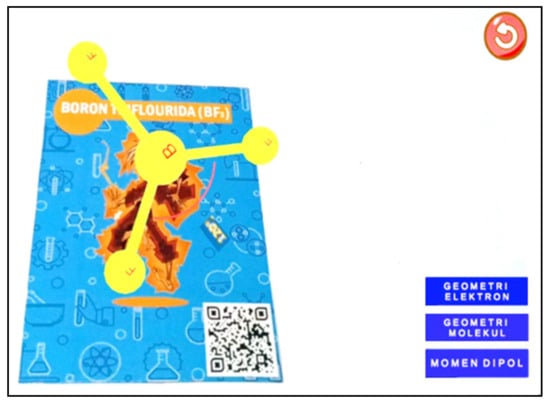
Figure 1.
3D media-based virtual representation.
Marker-based cards of seven different forms of molecules were used in the study. These included chloroform (CHCl3), boron trifluoride (BF3), phosphorus pentachloride (PCl5), methane (CH4), ammonia (NH3), water (H2O), and lactic acid (C3H6O3). Features contained in the 3D virtual representation media were electron geometry, features of molecular geometry, and features of dipole moments. Regardless of the utility of the media, it is still difficult to convince students to use 3D molecular models to learn concepts unless the model is provided by the teacher and directions given for its use in the lesson [58]. Therefore, 3D media can be a way to bridge this gap. Based on research conducted by Martín-Gutierrez et al., [18], the development of spatial abilities can be done using augmented reality in the learning process. Besides [59,60] concluded that AR is considered helpful for developing students’ spatial abilities because it helps them to visualize molecules, thereby providing a deeper understanding of chemistry.
The realistic view of the 3D molecular shape better describes the imaginary object and reduces the student’s cognitive load in integrating information from the macroscopic, microscopic, and symbolic chemical domains.
3. Methodology
3.1. Research Design
The study was conducted with a group of 36 students made up of 13 male and 23 female year 10 chemistry students learning molecular geometry. The participants were selected based on the year level and their willingness to participate in the research. We announced the study through email to our school partners. The molecular geometry curriculum aims to develop students’ understanding of molecule models, which requires them to have sound spatial abilities. Multiple data collection strategies were employed to explore students’ spatial ability in relation to chemistry learning, including a spatial ability assessment, a quiz to assess prior knowledge, student worksheets, interviews, observation sheets, reflective journals, and a molecular geometry test. An ethics clearance was obtained that included a participant consent form, sought permission to undertake the research, and provided details as to how the privacy of the participants would be maintained.
The research was conducted in three stages: a preliminary stage, a research implementation stage, and a final stage. The research flow is shown in Figure 2.
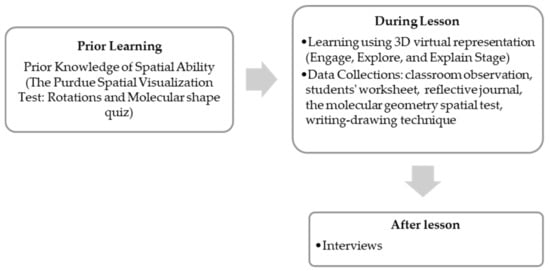
Figure 2.
Learning activities and data collection.
At the preliminary stage, researchers developed a chemistry lesson plan designed to train students’ spatial abilities using a 3D virtual representation of molecular geometry. At this stage, two assessments were conducted to explore the characteristics of students’ spatial ability and their prior knowledge of chemistry concepts that relate to molecular geometry concepts. An assessment of students’ spatial abilities was carried out using a validated PSVT: the R diagnostic assessment tool from Bodner and Guay (1997). The assessment quiz to explore students’ prior knowledge required them to determine the shape of the molecular geometry from a predetermined position.
During the lesson, activities from the engage, explore, and explain learning phases were implemented and classroom observations were conducted. In the engage phase, students were engaged in challenging tasks through questions and activities in a student worksheet. In the explore phase, students explored spatial information presented by the 3D virtual representation, and then in the explain phase, students were asked to explain and present the results from a problem-solving activity. During the lesson, a worksheet was given to the students to help their understanding of the molecular geometry concepts and to develop their spatial abilities. The worksheet required students to determine a molecular shape based on the VSEPR theory, determine bond angles in a molecule, determine molecular polarity based on bond moments, and interpret spatial information on the 2D and 3D molecular shapes topic. Observations were recorded in a central data-gathering tool used in this study; therefore, all forms of activity where students were engaged in learning using 3D virtual representation were observed using an observation sheet.
In the final stage of the lesson, students were given a spatial test of molecular geometry to assess their understanding and spatial ability. The spatial ability test was related to curricular chemistry concepts and was validated by four chemistry lecturers. The criteria for the spatial test of molecular geometry were based on the spatial abilities referred to by Lohman (1979), who identified spatial visualization, spatial orientation, and spatial relation [42]. Other data were gathered from student interviews and reflective journals.
3.2. Data Collection
The data in this study were obtained using a spatial ability assessment, a quiz to assess prior knowledge, student worksheets, interviews, observation sheets, reflective journals, and a molecular geometry test.
3.2.1. The Purdue Spatial Visualization Test: Rotations
The diagnostic assessment set at the beginning of the research project used PSVT: R to determine the students’ general spatial skills and knowledge. The PSVT: R used was the original version consisting of 20 questions designed to measure the visualization of 3D object rotation [61]. The test instructions require students to learn how the object on the top row of the question was rotated; to consider an image, such as whether the object displayed in the middle row of the question looked as if it were correctly rotated the same way; and to select one of the five pictures given in the bottom line of a question about whether it looked like the object had been rotated in the correct position. An example of the types of questions in this test are shown in Figure 3.
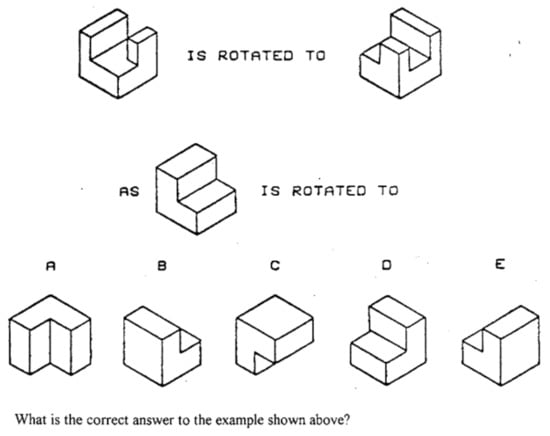
Figure 3.
Examples of types of questions in PSVT: R.
The students’ spatial ability scoring guidelines were adapted from scoring proposed by Bodner and Guay (1997) [61], where students were given one point for each question they answered correctly. As a result of the spatial test, students were divided into 3 groups representing low, medium, or high spatial abilities, as presented in Table 1 [61].

Table 1.
Guidelines for students’ spatial ability scores.
3.2.2. Quiz
A common molecular shape introduced to high school chemistry students is the valence shell electron pair resistance theory. The VSEPR model can predict the molecular structure and 3D shape of many chemical compounds. Students learn to predict and describe molecular shapes with different thought patterns from one student to another; spatial ability is the key to understanding it. A quiz can help find an outline of the three-dimensional spatial concept of molecular shapes in students’ cognition. Students complete the quiz by interpreting the shape of the molecule as it is observed from a predetermined position. An example of the questions in the quiz is shown in Figure 4.
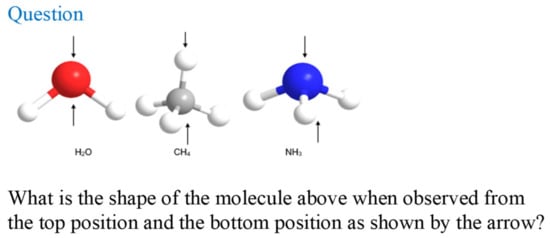
Figure 4.
Examples of the type of questions on the quiz.
3.2.3. Interview
A semi-structured interview was used in this study to elicit students’ ideas and views. Interviews were conducted for 15 min with a total of 9 students who were chosen based on data from the spatial ability test, worksheet, observations, reflective journal analysis, the molecular geometry test, and their level of engagement. All interviews were recorded and fully transcribed by the researcher with a focus on learning activities and the student’s spatial ability. Semi-structured interview questions were aimed at the effectiveness of 3D virtual representations for the students’ learning and perspectives as they reasoned with spatial information and performed tasks requiring spatial knowledge. Students were asked to identify the benefits of using 3D virtual representations in chemistry lessons and whether it improved their ability to see molecular shapes and reflect and rotate objects.
During the interview process, students were asked to visually describe the reflection, rotation, and determination of the molecular shape observed at various positions by using writing–drawing techniques. The writing–drawing techniques were used to obtain visual data on a student’s ability to reflect, rotate, and determine the shape of molecules in various positions. The following is an example of a question posed in the interview: “What would the molecule PCl5 look like if it were reflected on the XY plane, YZ plane, and XZ plane?”
3.2.4. Observation
Observations are useful for understanding the conditions of learning in class and the development of students’ spatial abilities. Observations were made during the learning process by using two observers who analyzed the characteristics of students’ spatial abilities when learning using 3D virtual representations. The observation sheet focused on the implementation of 3D virtual representations, students’ spatial ability, and students’ understanding and engagement in learning activities.
3.2.5. Student Worksheet
The student worksheet was completed during each of the learning stages. It consisted of activities and questions to help students develop their spatial ability and to understand the concepts. The worksheet consisted of activities relevant to aspects of spatial ability and molecular geometry concepts. The following is an example of the observation sheet used in this study (Figure 5).
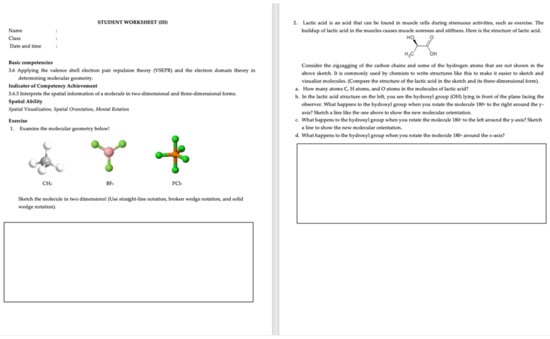
Figure 5.
Example of a student worksheet.
3.2.6. Reflective Journal
A reflective journal, completed during the learning process and at each meeting, captured student reflections on the challenges they faced and their level of engagement during the learning process. One example of a question in a reflective journal was, “Write down your reflections of today’s class in order to develop your spatial visualization skills.”
3.2.7. Molecular Geometry Test
At the end of the study a spatial test integrated with molecular geometry content was used to assess students’ learning of molecular geometry while using 3D virtual representation. Spatial abilities were divided into three aspects, as shown in Table 2 [42].

Table 2.
Aspects of spatial abilities.
An example of the questions in the molecular geometry test is shown in Figure 6.
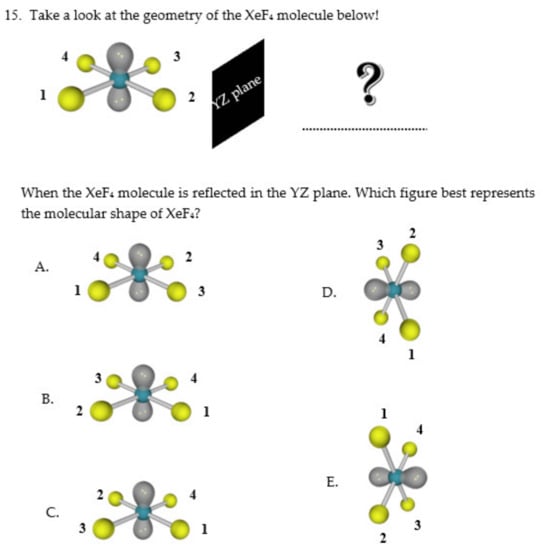
Figure 6.
Examples of a question in the molecular geometry test.
3.3. Data Analysis
A qualitative data analysis technique using data reduction, data display, and conclusion drawing/verification was used in this study [62]. Data analysis was divided into two stages. PSVT: R was used at the beginning of the research project to identify the students’ levels of spatial ability rated as high spatial ability, medium spatial ability, and low spatial ability. A quiz was then used to test students’ prior knowledge in concepts relevant to molecular geometry. The test was analyzed based on curricula content and learning outcomes.
The data from student worksheets, interviews, observation sheets, reflective journals, and molecular geometry were analyzed based on spatial ability aspects of visualization, spatial orientation, and spatial relationships. Student engagement during the implementation of the project was also analyzed.
At the data display stage, the researchers explained the findings based on the research question, drew conclusions, and verified them using credibility techniques such as prolonged engagement, persistent observation, progressive subjectivity, and member checking [63] to check the validity and trustworthiness of the data [63]. Prolonged engagement from November 2019 to May 2020 was used to understand the research context, engage the participants, and implement the project over a 5-week period. Persistent observation required the researcher to make continuous observations of the participants by being involving directly in the learning. Progressive subjectivity was used to monitor research results and researchers’ observation notes based on the characteristics of students’ spatial abilities. Member checking analyzed the characteristics of students’ spatial abilities and intentions. Two observers were used during the learning process to obtain primary data directly from research participants. The data was obtained in original hard paper copies and interview transcripts were stored on a private computer to maintain participant privacy and confidentiality.
4. Results and Discussion
Before the learning activities were introduced, the students completed a quiz aimed at finding their general spatial abilities. Students were asked to describe the shape of a molecule to a predetermined position. At the end of the lesson, students were given the Purdue Spatial Visualization Test: Rotation to provide more details about the characteristics of their spatial abilities.
4.1. Prior Knowledge and Spatial Ability Test
Prior knowledge was assessed through a quiz and spatial ability through a diagnostic assessment by using the PSVT: R. The test identified spatial abilities in three categories from high to low, as shown in Figure 7.
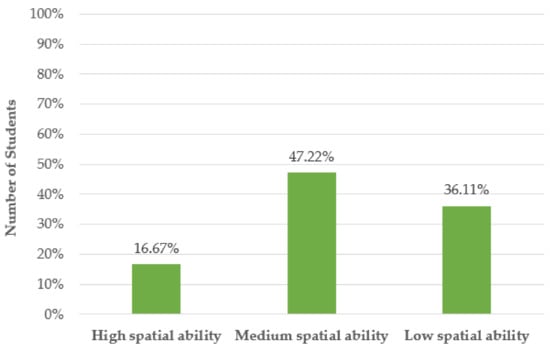
Figure 7.
Graph of the identification results of spatial ability in three categories from high to low.
The results revealed that 16.67%, around 6 students, scored in the high spatial ability category; 47.22%, around 17 students, scored in the moderate spatial ability category; and 36.11%, around 13 students, scored in the low spatial ability category. This indicates that most of the students had a moderate spatial ability. For the prior knowledge activity, students were asked to predict the shape of water, ammonia, and methane molecules. The results, as shown in Figure 8, indicate that most students (33 out of 36) correctly predicted the shape of the molecules.
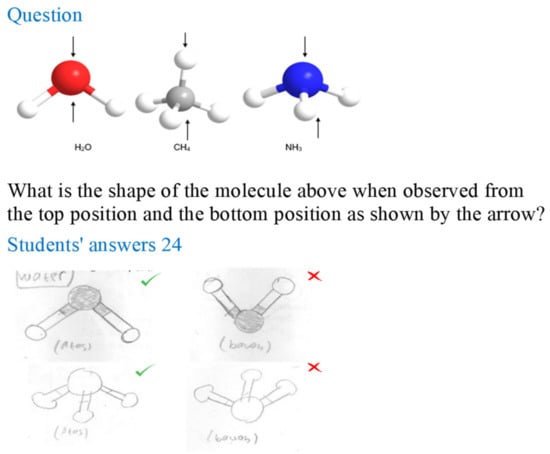
Figure 8.
Spatial interpretation of the geometry of water and ammonia molecules by student 24.
Figure 8 shows that some of the students’ answers were correct and some errors were evident. In this context, students already had some spatial abilities, however, they were not well honed. Margulieux reasoned that this gap in understanding is reduced when the spatial abilities of students are the result of a long learning and training process [8]. If viewed from the perspective of educational psychology, as explained by Jamaris [64], the cognitive development phase for high school students is included in the formal operations phase. This phase describes the ability of students to carry out various thought processes maturely and rationally when solving problems scientifically. In this case, students can perform mental operations without having to have a concrete form. Some students showed the spatial orientation arrangement of water, methane, and ammonia molecules in the image they made, as shown in Figure 9.
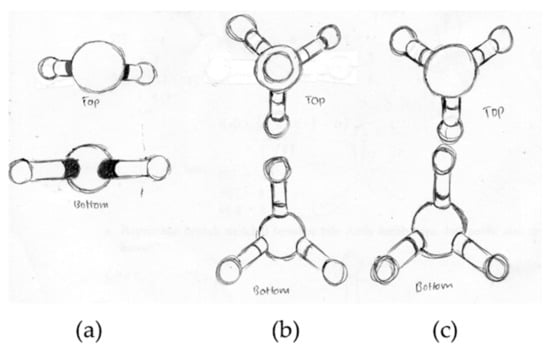
Figure 9.
(a) geometric models of water molecules, (b) geometric models of methane molecules, and (c) geometric models of ammonia molecules. The three molecules are the result of the spatial interpretation of molecular geometry that is observed at the top and bottom positions of the observer by students 19.
Figure 9 also shows that these students demonstrated sound spatial and drawing skills. According to [65], these two learning attributes demand the same brain function for information processing, where drawing is the output of visual perception that allows for the conversion of abstract visualizations into concrete products. In other words, the better a person’s drawing skills, the better their power of imagination and visualization of an object will be.
4.2. Implementation of Learning Using 3D Virtual Representation
4.2.1. Engage Phase
Students were given worksheets that contained a problem to determine a molecular shape based on the VSEPR approach for determining bond angles in a molecule, determining molecular polarity based on bond moments, and interpreting spatial information on 2D and 3D molecular shapes.
The worksheets were aimed at training and developing students’ spatial abilities by providing a stimulus in the form of a 3D molecular shape displayed by 3D virtual representation media. This approach is supported by Carlisle et al., [14], who stated that the development of spatial capabilities can be done using 3D virtual representations based on augmented reality. Learning activities carried out at the engage stage are identified in Figure 10 below.
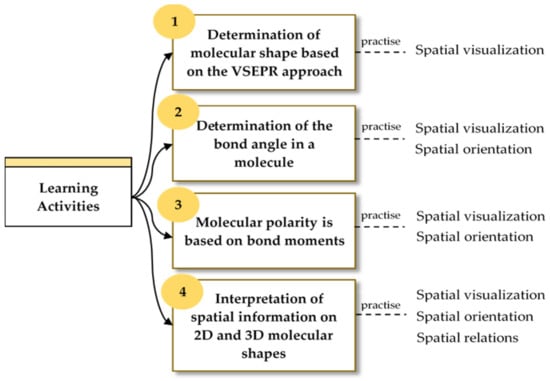
Figure 10.
Learning activities at the engage stage.
Learning was carried out in groups that were each given marker-based cards that functioned as a medium for displaying virtual objects. Students used a cellphone camera as a scanner to recognize the position and orientation of the markers.
4.2.2. Explore Phase
Students had to rely on their understanding of molecular geometry concepts as well as their ability to explore spatial information presented by the 3D virtual representation media. Because augmented reality-based 3D virtual representation media can present a full 3D hologram of molecular shapes, students were not required to translate 2D molecular images into 3D models [20], as demonstrated in the following student interview:
“… we visualize the shape of the molecule visually in the brain, it’s quite difficult. However, learning to use 3D virtual representation, the shape of the molecule can be rotated with your fingers and looks like a three-dimensional model.”(Interview 1, student 15, 3 February 2020)
Interview 1 shows the student’s learning was enhanced by the use of 3D virtual representation media. Students not only memorized the shape of a molecule, but they could also visualize and observe the 3D shape orientation of the molecule. During the explore activities, researchers could not assume that students would extract the necessary spatial information until visual images were displayed as 3D virtual representations in the learning phase that followed [66]. Therefore, an emphasis on training that helps students use, create, and interpret molecular representations in two- and three-dimensional forms needs to be an important aspect of the learning cycle, as per the statements below:
“The overall learning conditions are very conducive and students are enthusiastic about the use of AR-based 3D virtual representation media…”(Observation sheet 1, observer 1, 17 January 2020)
“It’s fun and I get a lot of new information.”(Reflective journal 1, students 19, 24 January 2020)
The observation and reflective journal excerpts from student 19 show that by providing alternative information in an innovative way, 3D virtual representations can be an effective way to learn molecular geometry. In addition to creating a conducive learning environment, the approach encourages multi-directional interactions between teachers and students. In addition to the learning resources provided by the teacher, students actively share their knowledge with other students during the learning process. The selection and use of appropriate media are also an important part of enhancing learning activities. [19] considered that the application of augmented reality-based 3D virtual representation media in learning encourages students to actively participate in shaping their own knowledge, especially in molecular geometry lessons.
4.2.3. Explain Phase
During this phase, students were asked to explain and present the results from a problem-solving activity that was carried out at the previous stage, as shown in Figure 11.
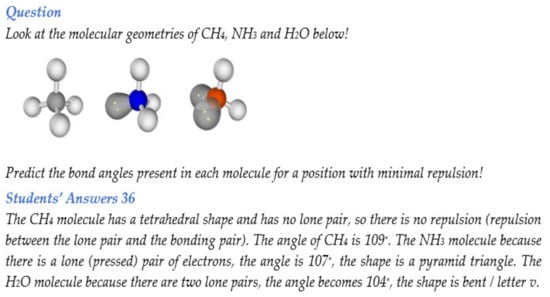
Figure 11.
Worksheet of student 36.
Figure 11 shows that this student was able to associate spatial information, arranged in its cognitive structure, with the concept of molecular geometry. In this activity, students were directed to carry out rational and empirical thinking processes to solve problems scientifically. The implication at the explain phase is that learning becomes meaningful and memorable for students since they were asked to explain the concept of molecular geometry after using 3D representations. Students benefited from learning via 3D virtual representations, as indicated by student 10:
“In my opinion, the benefits of these three-dimensional virtual representations in chemistry learning are very beneficial. In my own opinion, when the benefits were presented, I felt that about 80% was very useful because, for students and students, including myself, chemistry is a subject that is very difficult to imagine. But with this application, learning chemistry is very easy to imagine. For example, in the description of molecules, atomic positions, atom positions, atomic degrees, results when rotated, results, when reflected, are very helpful for us to see…“(Interview 2, student 10, 28 January 2020)
Students recognized the importance of having sound spatial abilities when learning chemistry concepts such as molecular geometry, an abstract topic [11].
4.3. Analysis of the Students’ Spatial Ability Aspects
The students’ spatial ability was analyzed from a molecular geometry test at the end of the lessons and by other data. The test consisted of 15 multiple-choice, open-ended questions divided into three aspects: spatial visualization, spatial orientation, and spatial relationships [67]. Researchers were able to observe the success or failure of students’ spatial abilities in molecular geometry from the spatial test. The level of the students’ achievement, based on an analysis of the molecular geometry spatial test, is presented in Figure 12.
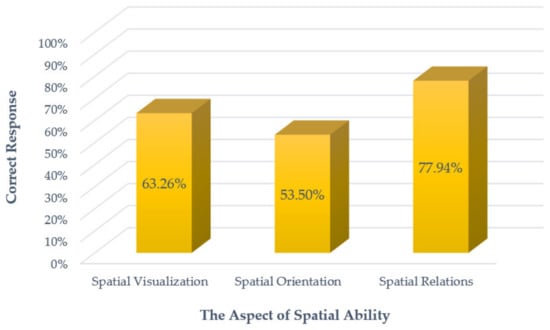
Figure 12.
Levels of attainment of students’ spatial abilities based on molecular geometry spatial tests.
The results presented in Figure 12 indicate that spatial orientation ranked the lowest of the three spatial abilities measured, with a percentage of 53.50%. Conversely, the aspect of spatial relationships ranked highest, with a percentage of 77.94%. These results demonstrate that the average level of spatial ability involves mental manipulation and rotation of 2D or 3D objects. This is reinforced by the observation data and reflective journals of student 12:
“Students do not experience difficulties when rotating the form of methane molecules found on student worksheets. Student 19 said that, “It’s easy, I just need to rotate this object…”(Observation 1, 10 January 2020)
“It’s fun even though it’s sometimes confusing and slow in understanding it (molecular geometry) because I’m weak at chemistry, but using applications (3D virtual representation media)…”(Reflective journal 2, student 12, 31 January 2020)
Therefore, success in the spatial relations aspect shows that students are able to imagine the rotation of 2D and 3D objects on the rotation axis through their cognitive structures.
4.3.1. Spatial Visualization
Spatial visualization measures the ability of students to carry out several spatial transformations such as manipulating, rotating, and reflecting objects that are more complex than spatial relationships or spatial orientation [6,34]. Students at the year 10 level are expected to be mentally able to manipulate and reflect molecular geometry in 2D and 3D. The results show that students were able to carry out spatial transformations on 2D and 3D molecules, as shown in Figure 13.
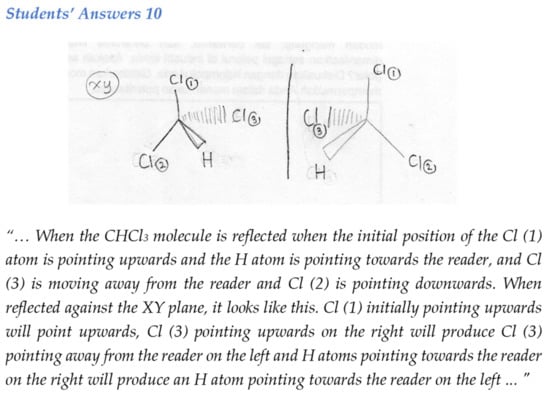
Figure 13.
Worksheet of student 10.
Figure 13 shows that student 10 could transform the 3D model of the molecule. Overall, students showed a strong preference for using analytical strategies when solving rotation and reflection problems. They were observed trying to imagine and analyze each atom contained in a molecule before carrying out the reflection process, an indication that the students developed their spatial visualization skills as a result of interpreting representations of molecular shapes. This is in accordance with research by [45,68], which explained that the analytic strategy focuses on details, where the object being manipulated is seen part by part, so it takes more time to complete. Analytical strategies have also been thought to help reduce students’ cognitive load through the application of rules and heuristics to spatial tasks [69]. Cognitive load theory is a theory used to study the limitations of working memory in receiving new information that is obtained. According to this theory, the amount of information that humans can process simultaneously is limited [70].
Previously, students had described the representation of the molecular shape as the Lewis structure. Through the study, students were trained in visualization skills as well as how to interpret molecular shapes. Using the knowledge gained throughout the learning process, students improved their spatial visualization skills to the point where they did not need to remember the structure of each molecule but could determine molecular geometry and draw conclusions about its chemical properties, as shown in Figure 14.

Figure 14.
Worksheet of student 9.
Figure 14 shows that student 9 could determine the polar properties of the molecule based on the geometry of the molecule and the electronegative constituent elements. Based on research conducted by Özmen, common misconceptions held by students regarding polar molecules consider that nonpolar molecules are formed when a constituent in the molecule has the same electronegativity [71]. Student 9 solved the problem correctly by determining that the polarity of the BF3 molecule was nonpolar, a result in accordance with the literature, which explains that the B-F bond is polar, but the molecule is nonpolar; the three terminal F atoms are identical and distributed symmetrically around the central atom of B, so that the bond moments of each B-F bond are canceled by the bond moments of the other two B-F bonds [72]. The results obtained were also confirmed by observation sheet 2 and reflective journal 3:
“Students are able to show the direction of the vector (dipole moment) to determine molecular polarity.”(Observation sheet 2, observer 2, 24 January 2020)
“It is very fun and easy to understand the material with the application (3D virtual representation media), for example, I can more easily understand and master the dipole moment material using the given application…”(Reflective journal 3, student 33, 24 January 2020)
4.3.2. Spatial Orientation
Spatial orientation measures a student’s ability to observe objects from different perspectives [6]. Students are expected to be able to visualize the place of the object to be manipulated to determine the position of the object or the result of the transformation on the object.
Figure 15a shows that students were able to interpret their perspective of three-dimensional objects, namely, the geometry of the NH2Cl molecule, which was projected onto a paper plane. The students’ statements above show that they were familiar with the notation of a 3D molecular structure represented in two-dimensional form. According to [67], this egocentric representation involves placing an object using a person’s body as a reference. By taking a spatial perspective, students imagine the rotation of objects against their viewpoints, not on objects that they manipulate mentally. This was identified by observation sheet 3 and researcher’s note 2.
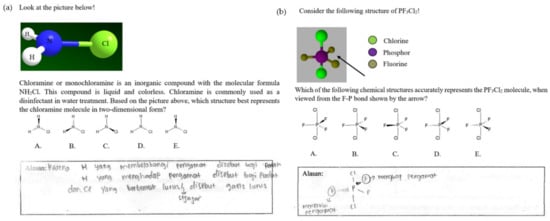
Figure 15.
(a) Spatial interpretation of the two-dimensional molecular structure of NH2Cl by student 3. (b) Spatial interpretation of the two-dimensional molecular structure of PF3Cl2 by student 27.
“… students can observe objects from different perspectives and are able to master the visualization of molecular shapes in the paper plane using straight line notation, broken wedge and solid wedge.”(Observation sheet 3, observer 1, 31 January 2020)
“The majority of students are able to visualize molecular shapes in 3D. Previously, they still drew molecular shapes like the Lewis structure.“(Researcher’s note 2, 17 January 2020)
Student 3’s statement is supported by Cracolive and Peters [73] that the straight-line notation states the bonds in the plane of the paper, the hatched wedge notation states the bonds pointing to the back of the paper, and the solid wedge notation states the bonds pointing out of the paper towards the observer. Students need this spatial orientation ability so that they can respond appropriately to spatial information when interpreting 3D representations of molecular shapes that are often used in chemistry. According to [72], since the shape of a molecule is three-dimensional, it is often difficult to describe it on paper. Therefore, chemists agreed to follow the notation of three-dimensional structures on two-dimensional paper such as straight line, hatched wedge, and solid wedge. Figure 15b demonstrates that students understood the three-dimensional representation of molecules presented on a paper plane. However, students did not precisely imagine and interpret the spatial information contained in the molecules, so it appears that the cognitive load as working memory used for mental rotation is influenced more by the angle of orientation rather than by the complexity of the object [67].
4.3.3. Spatial Relation
Spatial relationships measure a student’s ability to rotate 2D and 3D objects [2]. Students are expected to be able to imagine the rotation of 2D and 3D objects on the rotation axis through their cognitive structure. The results indicate that students were able to rotate 2D and 3D objects through their cognitive structures, as shown in Figure 16.
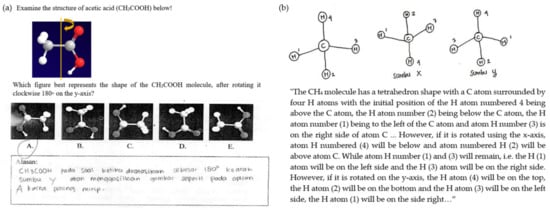
Figure 16.
(a) Spatial interpretation of the 3D molecular structure of acetic acid by student 10. (b) Worksheet of student 9.
Figure 16a shows two student responses to the activity that required them to rotate the three-dimensional structure of acetic acid 180° clockwise on the y-axis. The process of imagining the rotation of this 3D object into a different spatial orientation required cognitive manipulation and a spatial transformation of the object [74]. According to [68], there are two kinds of strategies that can be used in imagining object rotation: a holistic strategy and an analytic strategy. Figure 16a reveals that in the process of rotating objects, these students used a holistic strategy that views an object as a unit. This means that students did not see the arrangement of atomic spaces in the molecule one by one when rotating the object. By contrast, Figure 16b shows that the students used analytical strategies in imagining object rotation. This strategy focuses on details, where objects that are manipulated are seen part by part, taking more time to complete [68]. Students who had high spatial abilities tended to complete spatial information processing quickly. When the stimulus was given, the students immediately visually imagined using their cognitive structures. This means that students with high spatial abilities could process spatial information more efficiently than students with low spatial abilities [75]. This was reinforced by observation sheet 4 and researcher’s note 3:
“… has the ability to understand molecular theories and shapes faster than his peers…”(Observation sheet 4, observer 1, 18 January 2020)
“…It’s easy, I just need to rotate this object. It means that the shape of the object is the opposite of its initial form.“(Researcher’s note 3, 10 January 2020)
5. Conclusions and Implications
The development of various aspects of students’ spatial abilities appeared in the results of the molecular geometry spatial test. In the aspect of spatial visualization, students were able to reflect on and mentally manipulate molecular geometry in 2D and 3D forms with a success rate of 63.26%. In the aspect of spatial relationships, 77.94% of students were able to imagine the rotation of 2D and 3D objects on various rotating axes. Students used either holistic strategies or analytical strategies when doing mental rotations. In the aspect of spatial orientation, students were able to transform egocentric perspectives on 2D and 3D molecules with a 53.50% success rate. These results indicate that the average spatial ability of the students is at a level that involves the process of manipulating and imagining the rotation of objects against 2D or 3D objects. The results also show that the use of 3D virtual representations in learning can reduce the cognitive load of students in understanding, interpreting, and translating chemical representations at the submicroscopic level, such as atoms and molecules. Students who have high spatial abilities can store more spatial information in working memory, or process it more efficiently, resulting in better performance than students with low spatial abilities.
The use of 3D virtual representation media based on augmented reality is limited to the Android operating system, raising issues for its broader implementation as a learning tool. The adjustment of learning strategies to the characteristics of the material in developing the spatial abilities of students was another challenge faced by the researchers. In addition to the development of students’ spatial abilities, the research project created a conducive learning environment, learning was meaningful and memorable for students, and students’ enthusiasm for the lesson increased. It can, therefore, be concluded that the spatial abilities of students can be successfully developed using 3D virtual representation in molecular geometry. The skills that make up the spatial abilities of students are the result of a long learning and training process, meaning that the spatial abilities of students can change from time to time. Therefore, there is a need for spatial abilities to be taught explicitly to chemistry students.
The results of this research imply that if a student’s spatial abilities are developed their understanding of chemistry, at an advanced level, will improve, especially for topics relevant to the high school chemistry curriculum in Indonesia, such as learning isomerism. Teachers can incorporate the following suggestions into their teaching to improve their students’ special abilities:
- (1)
- Teachers can use 3D virtual representation as an alternative learning media that can develop students’ spatial abilities;
- (2)
- Teachers can use the learning strategies that were applied in this study to improve the spatial abilities of students, including the engage stage, explore stage, and explain stage;
- (3)
- Instructions for the use of 3D virtual representations can be created so that students can use them independently; and
- (4)
- Further research is needed to develop the spatial abilities of students on other chemistry learning topics.
Author Contributions
Research design, data collection, data analysis, and journal writing, Y.R.; re-search design and data analysis, H.D.; data collection, data analysis, and journal writing, F.A. All authors have read and agreed to the published version of the manuscript.
Funding
This research received no external funding.
Data Availability Statement
Not Applicable.
Acknowledgments
We would like to thank SMAN 59 Jakarta for participation in the research.
Conflicts of Interest
The authors declare no conflict of interest.
References
- Johnstone, A.H. Why science is difficult to learn: Things are seldom what they seem. J. Comput. Assist. Learn. 1991, 7, 75–83. [Google Scholar] [CrossRef]
- Gabel, D.L.; Briner, D.; Haines, D. Modeling with magnets: A unified approach to chemistry problem solving. Sci. Teach. 1992, 59, 58–63. [Google Scholar]
- Garnet, P.J.; Garnet, P.J.; Hackling, M.W. Students’ alternative conceptions in chemistry: A review of research and implications for teaching and learning. Stud. Sci. Educ. 1995, 25, 69–96. [Google Scholar] [CrossRef]
- Chittleborough, G.; Treagust, D.F. The modelling ability of non- major chemistry students and their understanding of the sub-microscopic level. Chem. Educ. Res. Pract. 2007, 8, 274–292. [Google Scholar] [CrossRef]
- Al-Balushi, S.M.; Al-Musawi, A.S.; Ambusaidi, A.K.; Al-Hajri, F.H. The Effectiveness of Interacting with Scientific Animations in Chemistry Using Mobile Devices on Grade 12 Students’ Spatial Ability and Scientific Reasoning Skills. J. Sci. Educ. Technol. 2017, 26, 70–81. [Google Scholar] [CrossRef]
- Harle, M.; Towns, M. A Review of Spatial Ability Literature, Its Connection to Chemistry, and Implications for Instruction. J. Chem. Educ. 2011, 88, 351–360. [Google Scholar] [CrossRef]
- National Research Council. Learning to Think Spatially; The National Academies Press: Washington, DC, USA, 2006. [Google Scholar]
- Margulieux, L.E. Spatial Encoding Strategy Theory. In Proceedings of the 2019 ACM Conference on International Computing Education Research; ACM: New York, NY, USA, 2019; pp. 81–90. [Google Scholar]
- Chang, H.-Y.; Linn, M.C. Scaffolding Learning from Molecular Visualizations. J. Res. Sci. Teach. 2013, 50, 858–886. [Google Scholar] [CrossRef]
- Carlisle, D. Spatial Reasoning in Organic Chemistry: From Novice to Expert the Missing Links; New England Educational Research Association: Portsmouth, NH, USA, 2013. [Google Scholar]
- Al-Balushi, S.M. The Relationship between Learners’ Distrust of Scientific Models, Their Spatial Ability, and the Vividness of Their Mental Images. Int. J. Sci. Math. Educ. 2013, 11, 707–732. [Google Scholar] [CrossRef]
- Wu, H.-K.; Shah, P. Exploring Visuospatial Thinking in Chemistry Learning. Sci. Educ. 2004, 88, 465–492. [Google Scholar] [CrossRef]
- Savec, V.F.; Vrtačnik, M.; Gilbert, J.K.; Peklaj, C. In-Service and Pre-Service Teachers’ Optionion on the Use of Models in Teaching Chemistry. Acta Chim. Slov. 2006, 53, 381–390. [Google Scholar]
- Carlisle, D.; Tyson, J.; Nieswandt, M. Fostering Spatial Skill Acquisition by General Chemistry Students. Chem. Educ. Res. Pract. 2015, 16, 478–517. [Google Scholar] [CrossRef]
- Terlecki, M.; Newcome, N.; Little, M. Durable and Generalized Effects of Spatial Experience on Mental Rotation: Gender Differences in Growth Patterns. Appl. Cogn. Psychol. 2008, 22, 996–1013. [Google Scholar] [CrossRef]
- Sorby, S. Educational Research in Developing 3-D Spatial Skills for Engineering Students. Int. J. Sci. Educ. 2009, 31, 459–480. [Google Scholar] [CrossRef]
- Kyllonen, P.C.; Lohman, D.F.; Snow, R.F.J. Effects of aptitudes, strategy training, and task facets on spatial task performance. Educ. Psychol. 1984, 76, 130–145. [Google Scholar] [CrossRef]
- Martín-Gutierrez, J.; Trujillo, R.E.N.; Acosta-Gonzalez, M.M. Augmented Reality Application Assistant for Spatial Ability Training. HMD vs Computer Screen Use Study. Procedia Soc. Behav. Sci. 2013, 93, 49–53. [Google Scholar] [CrossRef][Green Version]
- Sirakaya, M.; Cakmak, E.K. The Effect of Augmented Reality Use on Achievement, Misconception and Course Engagement. Contemp. Educ. Technol. 2018, 9, 297–314. [Google Scholar] [CrossRef]
- Hoe, Z.-Y.; Lee, I.-J.; Chen, C.-H.; Chang, K.-P. Using an Augmented Reality-Based Training System to Promote Spatial Visualization Ability for the Elderly. Univ. Access Inf. Soc. 2019, 18, 327–342. [Google Scholar] [CrossRef]
- Diaz, C.; Hincapié, M.; Moreno, G. How the Type of Content in Educative Augmented Reality Application Affects the Learning Experience. Procedia Comput. Sci. 2015, 75, 205–212. [Google Scholar] [CrossRef]
- Maulana, G.G. Penerapan Augmented Reality untuk Pemasaran Produk menggunakan Software Unity 3D dan Vuforia. J. Tek. Mesin 2017, 6, 74–78. [Google Scholar] [CrossRef][Green Version]
- Mahendra, M.; Bagus, I. Implementasi Augmented Reality (AR) menggunakan Unity 3D dan Vuporia SDK. J. Ilm. Ilmu Komput. Univ. Udayana. 2016, 9, 1–5. [Google Scholar]
- Ardhianto, E.; Hadikurniawati, W.; Winarno, E. Augmented Reality Objek 3D dengan [erangkat Artoolkitndan Blender. J. Teknol. Inf. DINAMIK 2012, 17, 107–117. [Google Scholar]
- Kamelia, L. Perkembangan Teknologi Augmented Reality Sebagai Media Pembelajaran Interaktif Pada Mata Kuliah Kimia Dasar. J. ISTEK 2019, 9, 238–253. [Google Scholar]
- Irwansyah, F.S.; Asyiah, E.N.; Farida, I. Augmented Reality-Based Media on Molecular Hybridization Concepts Learning. Tadris J. Kegur. Ilmu Tarb. 2019, 4, 227–236. [Google Scholar] [CrossRef]
- Aulawi, R.; Winarno, W.; Nasiri, A. Media Pembelajaran Interaktif Geometri Molekul Kimia Menggunakan Augmented Reality Berbasis Android. Indones. J. Appl. Inf. 2019, 3, 44–58. [Google Scholar]
- Setiahadi, H.; Setyati, E.; Setiawan, E.I. Pembelajaran Ikatan Molekul Dalam Pelajaran Kimia Menggunakan Augmented Reality. J. Inf. Comput. Technol. Educ. 2017, 1, 80–86. [Google Scholar]
- Krisnandry, F.; Bahri, S. Implementasi Teknologi Augmented Reality (AR) Pada Aplikasi Smart Book Reaksi Redoks Dan Elektrokimia Menggunakan Metode Marker Based Tracking Berbasis Desktop. Coding J. Komput. Appl. 2020, 8, 215–226. [Google Scholar]
- Chairunnisa; Sekarwati, K. Implementasi Augmented Reality Untuk Pengenalan Alat Laboratorium Kimia. Available online: http://digilib.mercubuana.ac.id/manager/t!@file_artikel_abstrak/Isi_Artikel_779327211508.pdf (accessed on 21 March 2021).
- Abubakar, A.I.; Darwiyanto, E.; Dwi, D.; Suwawi. Perancangan Media Pembelajaran Unsur Golongan IA Dan VIIA Periodik Kimia Dengan Teknologi Augmented Reality Menggunakan Metode Goal-Directed Design. E-Proc. Eng. 2019, 6, 9388–9398. [Google Scholar]
- Erlina; Cane, C.; Williams, D.P. Prediction! The VSEPR Game: Using Cards and Molecular Model Building To Actively Enhance Students’ Understanding of Molecular Geometry. J. Chem. Educ. 2018, 95, 991–995. [Google Scholar] [CrossRef]
- Barke, H.-D.; Engida, T. Structural Chemistry, and Spatial Ability in Different Cultures. Chem. Educ. Res. Pract. 2001, 2, 227–239. [Google Scholar] [CrossRef]
- Yilmaz, B. On the Development and Measurement of Spatial Ability. Int. Electron. J. Elem. Educ. 2017, 1, 83–96. [Google Scholar]
- Stieff, M. When Is a Molecule Three Dimensional? A Task-Specific Role for Imagistic Reasoning in Advanced Chemistry. Sci. Educ. 2011, 95, 310–336. [Google Scholar] [CrossRef]
- Merchant, Z.; Goetz, E.T.; Keeney-kennicutt, W.; Kwok, O.; Cifuentes, L.; Davis, T.J. The learner characteristics, features of desktop 3D virtual reality environments, and college chemistry instruction: A structural equation modeling analysis. Comput. Educ. 2012, 59, 551–568. [Google Scholar] [CrossRef]
- Oliver-Hoyo, M.; Babilonia-Rosa, M.A. Promotion of Spatial Skills in Chemistry and Biochemistry Education at the College Level. J. Chem. Educ. 2017, 94, 996–1006. [Google Scholar] [CrossRef]
- Mustofa, P.M.; Suleman, N. Hubungan Antara Kemampuan Berpikir Formal dan Kecerdasan Visual-Spasial dengan Kemampuan Menggambarkan Bentuk Molekul Siswa Kelas XI MAN Model Gorontalo Tahun Ajaran 2010/2011. J. Entrop. 2013, 8, 551–561. [Google Scholar]
- Barnea, N.; Dori, Y. High-School Chemistry Students’ Performance and Gender Differences in a Computerized Molecular Modeling Learning Environment. J. Sci. Educ. Technol. 1999, 8, 257–271. [Google Scholar] [CrossRef]
- Yezierski, E.; Birk, J. Misconceptions about the Particulate Nature of Matter. Using Animations To Close the Gender Gap. J. Chem. Educ. 2006, 83, 954. [Google Scholar] [CrossRef]
- Cole, M.; Wilhelm, J.; Vaught, B.M.M.; Fish, C.; Fish, H. The Relationship between Spatial Ability and the Conservation of Matter in Middle School. Educ. Sci. 2021, 11, 4. [Google Scholar] [CrossRef]
- Lohman, D.F. Spatial Ability: A Review and Re-Analysis of the Correlational Literature; Stanford University: Stanford, CA, USA, 1979. [Google Scholar]
- Chinthammit, W.; Yoo, S.; Parker, C.; Turland, S.; Pedersen, S.; Fu, W.-T. MolyPoly: A 3D Immersive Gesture Controlled Approach to Visuo-Spatial Learning of Organic Chemistry. In Computer-Human Interaction: Cognitive Effects of Spatial Interaction, Learning, and Ability; Wyerd, T., Calder, P., Shen, H., Eds.; Springer: Cham, Switzerland, 2015; pp. 153–170. [Google Scholar]
- Tuckey, H.; Selvaratnam, M.; Bradley, J. Identification and Rectification of Student Difficulties Concerning Three-Dimensional Structures, Rotation, and Reflection. J. Chem. Educ. 1991, 68, 460–464. [Google Scholar] [CrossRef]
- Kiernan, N.A.; Manches, A.; Seery, M.K. The role of visuospatial thinking in students’ predictions of molecular geometry. Chem. Educ. Res. Pract. 2021, 22, 43–61. [Google Scholar]
- Lohman, D.F.; Kyllonen, P.C. Individual Differences in Solution Strategy on Spatial Tasks. In Advances in the Psychology of Human Intelligence; Dillon, R.F., Schmeck, R.R., Eds.; Academic Press: New York, NY, USA, 1983; pp. 105–135. [Google Scholar]
- Myers, C.T. Some Observations of Problem Solving in Spatial Relations Tests (ETS RB 58-16); Educational Testing Service: Princeton, NJ, USA, 1958. [Google Scholar]
- Gilbert, J. Visualization: A Metacognitive Skill in Science and Science Education. In Visualization in Science Education; Gilbert, J.K., Ed.; Springer: Dordrecht, The Netherlands, 2005; pp. 9–27. [Google Scholar]
- Smith, G.G.; Ritzhaupt, A.D.; Tjoe, E. Strategies in Visuospatial Working Memory for Learning Virtual Shapes. Appl. Cogn. Psychol. 2010, 24, 1095–1114. [Google Scholar] [CrossRef]
- Setyarini, M.; Liliasari, L.; Kadarohman, A.; Martoprawiro, M.A. Efektivitas Pembelajaran Stereokimia Berbasis Visualisasi 3D Molekul Untuk Meningkatkan Kemampuan Spasial. J. Cakrawala Pendidik. 2017, 36, 91–101. [Google Scholar] [CrossRef]
- Sirakaya, M.; Cakmak, E.K. Investigating Student Attitudes toward Augmented Reality. Malays. Online J. Educ. Technol. 2018, 6, 30–44. [Google Scholar]
- Núñez, M.; Quirós, R.; Núñez, I.; Carda, J. Collaborative Augmented Reality for Inorganic Chemistry Education. In IASME International Conference on Engineering Education; Mauri, J., Zaharim, A., Eds.; WSEAS: Stevens Point, WI, USA, 2008; pp. 271–277. [Google Scholar]
- Saidin, N.F.; Abd Halim, N.D.; Yahaya, N. Framework for Developing a Mobile Augmented Reality for Learning Chemical Bonds. Int. J. Interact. Mob. Technol. 2019, 13, 54–68. [Google Scholar] [CrossRef]
- Nachairit, A.; Srisawasdi, N. Using Mobile Augmented Reality for Chemistry Learning of Acid-Base Titration: Correlation between Motivation and Perception. In Proceedings of the 23rd International Conference on Computers in Education ICCE; Ogata, H., Chen, W., Kong, S., Qiu, F., Eds.; Asia-Pacific Society for Computers in Education: Ishikawa, Japan, 2015; pp. 519–528. [Google Scholar]
- Kusuma, S.D.Y. Perancangan Aplikasi Augmented Reality Pembelajaran Tata Surya Dengan Menggunakan Marker Based Tracking. J. Inform. Univ. Pamulang 2018, 3, 33–38. [Google Scholar] [CrossRef]
- Cheng, J.C.; Chen, K.; Chen, W. Comparison of Marker-Based Ar and Markerless Ar: A Case Study on Indoor Decoration System. In Proceedings Lean & Computing in Construction Congress (LC3); Bosché, F., Brilakis, I., Sacks, R., Eds.; Edinburgh: Heraklion, Greece, 2017; pp. 1–8. [Google Scholar]
- Young, J. Marketing Communication Menggunakan Augmented Reality pada Mobile Platform. Ultim. J. Teknik Inform. 2015, 7. [Google Scholar] [CrossRef]
- Behmke, D.; Kerven, D.; Lutz, R.; Paredes, J.; Pennington, R.; Brannock, E.; Deiters, M.; Rose, J.; Stevens, K. Augmented Reality Chemistry: Transforming 2-D Molecular Representations into Interactive 3-D Structures. Proc. Interdiscip. STEM Teach. Learn. Conf. 2018, 2, 5–11. [Google Scholar] [CrossRef]
- Cai, S.; Wang, X.; Chiang, F.-K. A Case Study of Augmented Reality simulation system application in a chemistry course. Comput. Hum. Behav. 2014, 37, 31–40. [Google Scholar] [CrossRef]
- Broman, K.; Mårell-Olsson, E.; Johnels, D.; Andersson, C.; Chorell, E.; Westerlind, U.; Boström, J.; Norrby, M. Spatial Ability in Organic Chemistry: Can Virtual and Augmented Reality be Valuable? In Proceedings of the 7:e Utvecklingskonferensen för Sveriges Ingenjörsutbildningar 2019, Luleå Tekniska Universitet, Luleå, Greece, 27–28 November 2019; Available online: http://urn.kb.se/resolve?urn=urn:nbn:se:umu:diva-165507 (accessed on 21 March 2021).
- Bodner, G.; Guay, R. The Purdue Visualization of Rotations Test. Chem. Educ. 1997, 2, 1–17. [Google Scholar] [CrossRef]
- Miles, M.; Huberman, A. Qualitative Analysis: An Expanded Source Book, 2nd ed.; Sage: Thousand Oakes, CA, USA, 1994. [Google Scholar]
- Guba, E.G.; Lincoln, Y. Fourth Generation Evaluation; Sage Publications: Newbury Park, CA, USA, 1989. [Google Scholar]
- Jamaris, M. Orientasi Baru Dalam Psikologi Pendidikan; Ghalia Indonesia: Bogor, India, 2013. [Google Scholar]
- Orde, B. Drawing as Visual-Perceptual and Spatial Ability Training. In ERIC Inst. Educ. Sci.; 1997. Available online: https://eric.ed.gov/?id=ED409859 (accessed on 29 August 2020).
- Schwartz, D.; Heiser, J. Spatial Representations and Imagery in Learning. In The Cambridge Handbook of The Learning Sciences; Sawyer, R., Ed.; Cambridge University Press: Cambridge, UK, 2005; p. 27. [Google Scholar]
- Ramful, A.; Lowrie, T.; Logan, T. Measurement of Spatial Ability: Construction and Validation of the Spatial Reasoning Instrument for Middle School Students. J. Psychoeduc. Assess. 2017, 35, 709–727. [Google Scholar] [CrossRef]
- Janssen, A.B.; Geiser, C. On the Relationship between Solution Strategies in Two Mental Rotation Tasks. Learn. Individ. Differ. 2010, 20, 473–478. [Google Scholar] [CrossRef]
- Hegarty, M.; Stieff, M.; Dixon, B.L. Cognitive change in mental models with experience in the domain of organic chemistry. J. Cogn. Psychol. 2013, 25, 220–228. [Google Scholar] [CrossRef]
- Schnotz, W.; Kürschner, C. A Reconsideration of Cognitive Load Theory. Educ. Psychol. Rev. 2007, 19, 469–508. [Google Scholar] [CrossRef]
- Özmen, H. Some Student Misconceptions in Chemistry: A Literature Review of Chemical Bonding. J. Sci. Educ. Technol. 2004, 13, 147–159. [Google Scholar] [CrossRef]
- Moore, J.; Stanitski, C.; Jurs, P. Chemistry The Molecular Science, 4th ed.; Cengage Learning: Monterrey, CA, USA, 2011. [Google Scholar]
- Cracolive, M.; Peters, E. Introductory Chemistry An Active Learning Approach, 6th ed.; Cengage Learning: Boston, MA, USA, 2014. [Google Scholar]
- Guillot, A.; Hoyek, N.; Collet, C. Mental Rotation and Functional Learning. In Encyclopedia of the Sciences of Learning; Seel, N., Ed.; Springer: Boston, MA, USA, 2012; pp. 2222–2223. [Google Scholar]
- Khooshabeh, P.; Hegarty, M. Representations of Shape during Mental Rotation. In Cognitive Shape Processing, Papers from the 2010 AAAI Spring Symposium; Barkowsky, T., Bertel, S., Hölscher, C., Shipley, T., Eds.; The AAAI Press: Stanford, CA, USA, 2010; pp. 22–24. [Google Scholar]
Publisher’s Note: MDPI stays neutral with regard to jurisdictional claims in published maps and institutional affiliations. |
© 2021 by the authors. Licensee MDPI, Basel, Switzerland. This article is an open access article distributed under the terms and conditions of the Creative Commons Attribution (CC BY) license (https://creativecommons.org/licenses/by/4.0/).